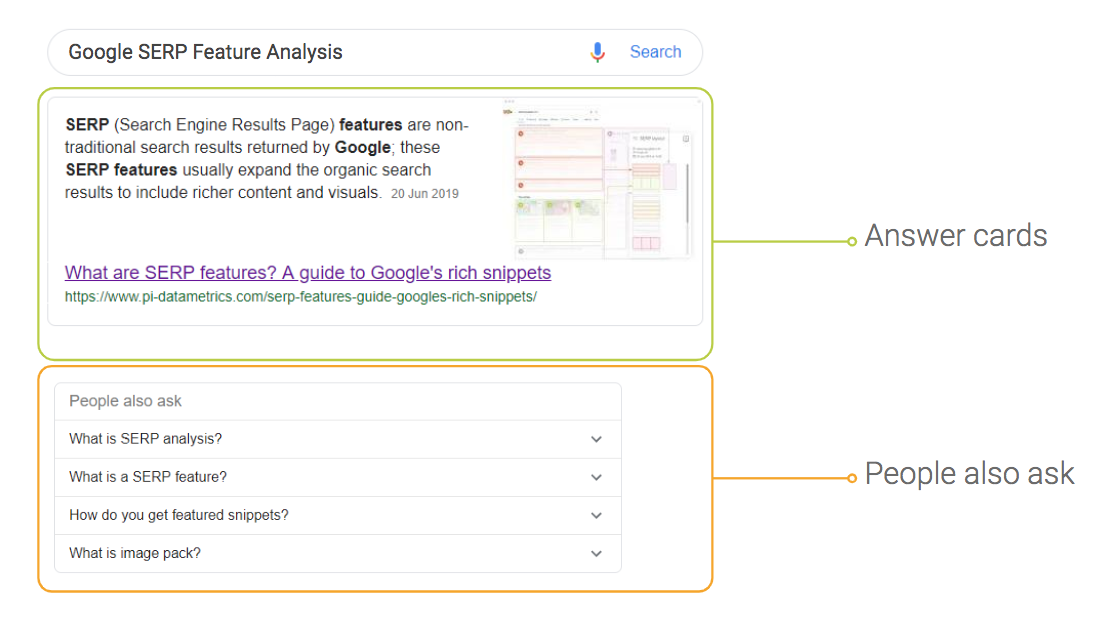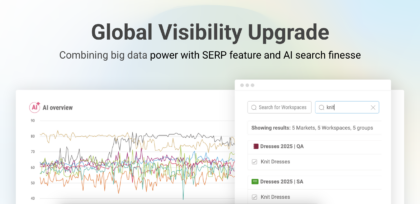Featured snippets: What are they & how do you own them? | SEO in the Shed
13 Feb 2020|5 MIN READ
Hi, Jon Earnshaw here, Chief Product Evangelist at Pi Datametrics! Welcome to my Featured Snippet 'SEO in the Shed' videos, where I share my musings, insights and takeaways with you from the comfort of my garden shed, no less!
The Featured Snippet Update – January 23rd:
On January 23rd Google made an update to Featured Snippets, or ‘Answer cards’ as we like to call them at Pi.
It had long been the case that, to own these features, you would need to have content that already ranked on page one – and in some rare cases, page two.
To many, this provided ‘Contingency traffic’, giving the searcher a second chance to click-through.
Featured Snippet: The 2020 cheatsheet
Google omits the Classic Link tied to a Featured Snippet
Since the 23rd Jan update, Google has started to omit the secondary Classic Link result if a website already owns the related Featured Snippet.
This was another one of Google’s ‘Declustering’ missions – I.e. An attempt to rid the Google SERPs of replica content from a single site, to provide more variety and enhance the search experience.
But many in the SEO community are unhappy about this – their main issue being the potential loss of traffic they might incur as a result.
Rand Fishkin’s 2019 Spark Toro study already suggested that Featured Snippets significantly reduced CTR’s, so this update is seemingly another blow to their traffic!
Should we be ditching the Featured Snippet altogether?
Some SEOs are so irked by the update, that they are looking for ways to find out their hidden rankings, and delete their Featured Snippets altogether.
But what if I were to tell you that you could still appear in both results – and even more – AND still provide a rich experience that satisfies the user?
STOP – don’t delete your Featured Snippets! There’s another way
Google reminds us time and time again that we just need to be better curators of our ecosystems, and this update is no different.
By practising a bit of contextual content optimisation, and building our digital ecosystem, we can still ensure multiple doorways to our website, for our most important and valuable searches.
Watch my video to find out how!
Or download my newly updated Featured Snippet cheat sheet!
Featured Snippet: The 2020 cheatsheet
How to get a Featured Snippet
Google is one of the most trusted sources of news, beating media agencies. People go to it for guidance and information, from the trivial to the vital.
For reasons of reputation management, it is important to have friendly and accurate sources in the top results of Google. But in recent years the requirement has grown in scope.
Google now provides not just answers to your searches (Answer Cards), but prompts for related searches that other people have asked (People Also Ask), and a whole host of other information sources, known as SERP Features.
These features are a reflection of searcher intent. They can help you get inside the mind of the searcher.

What is Google’s Answer Card feature?
A Google ‘Answer card’ is a SERP feature, that appears above the organic results and seeks to directly answer a specific question. It is reliant on schema markup, which enables Google to crawl the page, and scrape content that is pertinent to the question.
What is Google’s People Also Ask Feature?
Google’s ‘People Also Ask’ feature is a curation of computer generated answers to queries, which use a number of signals to keep the generated query relevant. Because of this, the boxes are seemingly infinite, if you click on the boxes it generates more boxes, and this will go on and on, with the queries becoming more and more unrelated and potentially nonsensical.
In both examples, Google is looking for small serviceable answers. No more than a paragraph or a couple of bullet points that give a snapshot to the answer.
What are the benefits of Featured Snippets?
- You have a visual advantage
- You are recognised as thought leader and may gain more trust as you’ve succinctly matched search intent
- You are often able to take up two spaces on page 1 of the SERPs; position 0 and your original position – although this may be changing
What are the disadvantages of Featured Snippets?
Because these features are so effective in providing results, your traffic might drop.
In fact, a recently updated study by RandFishkin from SparkToro, shows that 50% of Google searches result in no-click.
According to Josef Wallis from BooxsScale “Googles first KPI was how quickly they could hand off a user from the search engine to a website. Now its the opposite”

But are these Google features really ‘stealing clicks’?
It isn’t possible to present full answers to a lot of queries in most cases, so it’s therefore rare for the snippet to carry enough information to entirely satisfy people’s queries.
Matthew Hunt also made this great statement on LinkedIn, on the subject:
“Less traffic does not mean fewer opportunities, just different opportunities!”
And that is so right. If we lose this kind of traffic, will it really affect our ROI? Or will it just impact our vanity traffic?
The majority of the queries that are succinctly answered within the SERPs, would never result in a sale or conversion in the first place.
Is this, therefore, a faux fear?
In my mind, these features provide the opportunity for your brand to gain immeasurable brand awareness and trust.
So, without further ado, how do we appear in the ‘Answer card’?
How do you optimize for Featured Snippets?
- Get on page 1
- Target any US answer cards in the UK, as a quick win
- Create something better than the current Answer Card / Provide updated information, and Google will prioritise this ‘Freshness’
- Take the most frequent PAA questions & create SEO content to match*
- Focus on the most frequently asked types of questions: “How”, “Is” and “Why”
- Match the format of the current ‘Answer card’ if it works. If not…
- Decide on what will look best – a numbered list, BPs or paragraph.
- If it’s a paragraph use close to 45 to 50 words.
- If it’s a list or table, format as such.
- Use clean HTML – make Google’s life easy.
- Use a CTA.
- Make it clear that there is ‘More detail’ to encourage click through.
- Include the question in the Title and potentially the H1.
- Be accurate and approach the topic from a position of authority.
- Cite available sources further down the page.
- Make sure all content on the page matches question intent.
- Link from a related webpage, using the PAA text as the anchor.
* Map People Also Ask question data to your high volume search term, to build out a content strategy that understands the multiple pathways a user can take. You can then track the appearance of these questions over a week, identify the most prominent one, and answer it succinctly within your content.
Thanks for reading and / or watching. I hope you found the above useful! For even more takeaways, download my Featured Snippet Cheat Sheet Below:
Featured Snippet: The 2020 cheatsheet
And for more content like this, you can do one of a few things:
- Subscribe to my monthly Shed News email, where I’ll be sharing all my latest content!
- Subscribe to Pi Datametrics’ YouTube channel for my upcoming videos – which I’ll be posting regularly!
- And, finally, follow me on Linkedin or Twitter.
Never miss a post
Join our mailing list and have our SEO news delivered straight to your inbox.





